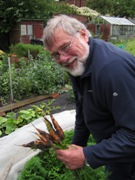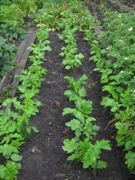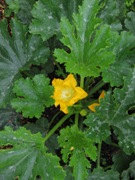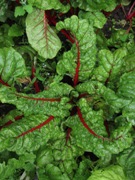Family garden allotments have been being used in England since the 1700s. Typically, a town council provides a tract of land and sets up an allotment association to manage the allotment and coordinate with the individual gardeners. During WW II Victory Garden days, families were given a 10 yard by 30 yard (today they are measured in meters) standard plot: large enough to provide vegetables for a family of 4.
Crop List:
Fennell
Winter broccoli
Kale
Cabbage
Sweed
Red Cabbage
Spring Cabbage
Swiss Chard
Leeks
Parsnips
Zucchini (courgettes)
Beet root
Beet spinach
Carrots
Potatoes (Yukon Gold, Desiree, Pink Fir Apple)
Squash (4 types)
Broad beans
Runner Beans
Gooseberries
Onions
Challenges:
Two of his biggest challenges are pigeons which eat his brassicas (He covers the beds with green netting), carrot root fly (he covers the beds with Enviromesh—an air and water permeable sheet), and slugs.
Soil & Water
For soil and water conservation from September through May he uses a black fabric mulch—which lets water through—but reduces weed growth, evaporation and top-soil nutrient loss through erosion.
David double digs his raised beds, places horse manure in the bottom as he digs, and liberally applies compost which he makes.
All and all, David’s garden is bountiful and I was able to enjoy several wonder meals made from his garden harvest: 4 different vegetables at each meal including salads, root crops roasted with a bit of olive oil, and a wonderful English dessert–gooseberry fuul.
See David’s Allotment:
http://wiki.worldflicks.org/wellington_road_allotments.html
Next week we visit an allotment garden in Coventry England. This allotment is much larger than the allotment in Manchester and covers an area of 3 or 4 city blocks. They have 180 full allotments
Learn how to develop a community centered, impact oriented project.






